Red Shift is a freeware Japanese visual novel which was first released in Japan for Windows as Tokoyo no Hoshizora on November 5, 2005. Red Shift, the official English localization, was made available for Windows, Linux, and MacOS on April 2, 2006. This visual novel was a pre-submission to the 2006 al|together translation festival, wherein a significant number of freeware doujin (independent) Japanese visual novels were translated into English. In this article, I review Red Shift as part of my ongoing project to review nearly all of the 30 Japanese visual novels officially translated as part of the 2005, 2006, and 2008 al|together translation festivals.
You can learn more about my al|together project by reading my project introduction article. That article includes a running list of our completed al|together reviews. I have a dedicated collection post with links to all of our al|together articles, including reviews, essays, and short posts.
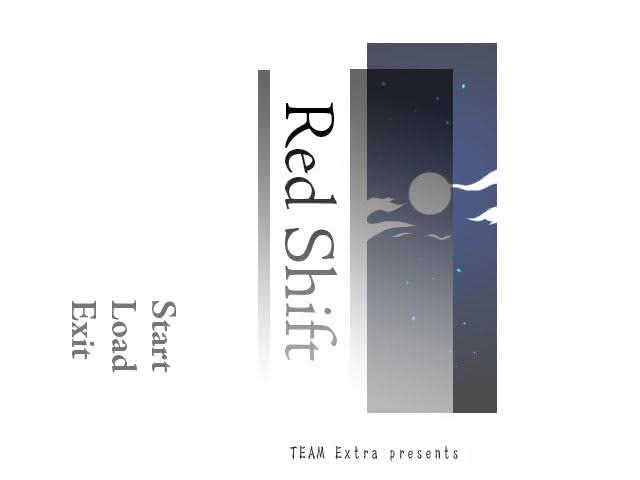
This post will be a largely spoiler-free review of Red Shift, meaning it is amenable for reading by people who may be interested in reading the free visual novel for themselves as well as those who have already read it in the past. I will describe the story in more detail below but, in short, it centers on several chance meetings between the view-point character, a 17-year old boy, and a similarly-aged somewhat-mysterious albino girl in a park near his home.
In addition to this review, I also published an article on hair color and albinism in Red Shift as part of my ongoing series on hair color in anime and visual novels.
Red Shift Details
Original Japanese Release
| Name | Tokoyo no Hoshizora |
|---|---|
| Developer | Team Extra |
| Release Date | November 5, 2005 |
| Engine | NScripter |
English Translation
| Name | Red Shift |
|---|---|
| Translator | Seung Park (Insani) |
| Release Date | April 2, 2006 |
| Engine | ONscripter Insani Experimental |
| Official Website | Insani; altogether 2006 |
| Visual Novel Database | VNDB Link |
Download Links
- Official Torrents: Insani, al|together 2006
- HTTP Direct Download: Kaisernet
Notes on Red Shift’s Relationship to al|together
Red Shift is one of two translations that were submitted to al|together 2006 during the festival’s “precursor phase.” According to the al|together website, the two precursor projects were “sample translations” done by Insani, the single-biggest contributor to the al|together festivals, “[t]o whet people’s appetite for the festival.” Insani also used an experimental version of the ONScripter visual novel scripting engine for Red Shift – a point I will explore below.
For purpose of my survey, I will treat Red Shift and its fellow precursor translation,Flood of Tears, as a full-fledged member of the al|together collection. One interesting point is that, despite being sample translations, both Red Shift and Flood of Tears are among the longer al|together visual novels, although both are shorter than the longest project, 2008’s May Sky.
Downloading and Running Red Shift
The al|together 2006 website lists both direct downloads and torrents for Red Shift. However, unlike most of the al|together 2006 games, the Red Shift direct download links no longer work (this is also true of Flood of Tears). The Insani website only lists the torrent download links, which do work.
However, the Red Shift torrents are temperamental. They are not fully dead, but successfully obtaining Red Shift through the torrent download requires patience.
While I encourage people to download and seed the Red Shift torrent if possible, people who just want to play the game do have direct download options.
Kaisernet, a very valuable website for ONScripter visual novel information, mirrored direct downloads for a number of al|together visual novels and, including Red Shift. I tested the direct download link and it does work. One caveat is that the Kaisernet download link is only for the Windows .exe for Red Shift, whereas there are torrents (sort of) available for the Linux and MacOS versions. The Red Shift .exe runs fine on Linux under WINE (I have not tried running Red Shift on MacOS or Windows). However, one can run the .exe natively on Linux, MacOS, or BSD by unpacking its contents and then running ONScripter-En (or another version thereof) in the directory with the extracted contents of the .exe. I explained the process for doing this in a full article guide.
Secondly, a group of visual novel enthusiasts, including with one of the Insani maintainers, worked together to collect a number of translations, including the Windows, Linux, and MacOS versions of Red Shift, and make them available for direct download from Mega. I contributed by finding Manatsu no Kagerou to add to the collection. In this case, I would recommend using the Kaisernet link, but I include the Mega link as an additional option.
While I encourage people to seed the al|together torrents if possible since this is how most people will discover the game, the Kaisernet link is the easiest way to obtain Red Shift as of the publication of this review.
I will update this section with more information if there is an easier solution in the future (which is an ongoing project of mine).
Red Shift-specific ONScripter Notes
Red Shift, like most of the al|together visual novels, is written in ONscripter, a free and open source implementation of a Japanese visual novel scripting engine called NScripter. (See my review of one of the exceptions, Summer, Cicada, and the Girl, which is written in KiriKiri and requires a Japanese language environment to run.)
Red Shift uses an experimental version of ONScripter. The Insani website observes that this version of ONScripter was used specifically for Red Shift and may have compatibility issues with other implementations of the engine. However, I ran into no serious issues running the Windows version of Red Shift under WINE on Linux. I saw many complaints about crashing on Visual Novel Database. I crashed on one occasion running the Windows version on WINE (it froze in an early scene change). I switched to a different version of WINE on Lutris and played the remaining two-plus hours entirely crash-free without a hitch, so it is possible that some versions of WINE may work better than others – or my experience could merely be bad luck followed by good.
The Linux version of Red Shift launches and runs without any obvious issue, but I did not play it straight through to test for issues. I did see one Visual Novel Database comment that the version of ONScripter that I used to launch Red Shift had resolved its apparent crashing issues.
Despite some notes of caution from Visual Novel Database users, I doubt that most people will have issues running Red Shift in the same manner they run the other al|together visual novels which rely on ONScripter. I would recommend setting occasional save points just in case.
If you happen to have an ONScripter issue with Red Shift, I recommend consulting the official documentation and Kaisernet’s useful guides. Red Shift’s Readme file also contains ONScripter instructions, but I note that they may be out-dated.
Note on My Review
My review is based on the Windows version of Red Shift, which I ran under WINE on Linux. When I decided to review Red Shift, I was having issues installing the ONScripter-En package on my Linux distribution (EndeavourOS, based on Arch Linux), and the Ponscripter package I have installed (Sekai Project fork) renders Red Shift at a resolution that does not suit it well (see my guide on running ONScripter-En and PONScripter on Linux). However, after my review, I tested the Linux version with a different method for running ONScripter-En on Linux, which I detailed here, and it worked without issue. I subsequently learned how to extract the contents of Windows .exe files and run ONScripter-En in the resulting directory, which I described here.
General Overview of Red Shift
The official Insani website for Red Shift provides a synopsis of the visual novel in verse:
This is how the most selfish girl in the world and the most selfish boy in the world make peace: Bells in the darkness that ensnare Heaven's silver light inside the inscrutable polyphony of far-off constellation.
I will forgive you if you do not come away from that introduction with a clear and distinct idea of what Red Shift is about – although the word choices in the verse make more sense after having read Red Shift. A translator’s note in the game’s Readme file alludes to this idea:
This [was] internally code-named ‘Project Polyphony’. It will become obvious why we gave this piece this particular code name as you read it through.
(While acknowledging that the description makes sense after having read Red Shift, I do not think that it makes for a great sales pitch. For example, describing the main character duo as selfish does make sense – but not precisely in the way that someone reading this description might think. I suspect that the description may give some potential readers an unjustifiably negative first impression. The proverbial sales pitch should focus more on making the case to prospective readers than eliciting nods from people who already read it.)
My no spoiler commitment restricts what I can say about the story, so I will stick to a short introduction.
The entire story of Red Shift is seen from the perspective of Kouya Ayakawa, a 17-year-old high school sophomore who attends a school where he is one of only three boys and serves as student council vice president. While that sounds like the set-up for a terrible generic harem visual novel, Kouya’s school never makes an actual appearance, and he assures us that his situation is more difficult than boys might imagine. Both of his parents are dead – his father died before he was born and his mother died shortly after he was born – so he lives with his adult sister, who is a medical resident.
One evening while walking home, Kouya encounters Mikoto, a petulant albino girl who appears to be his age. She demands that he vacate his spot on a park bench because it is “her” spot. Kouya refuses and an argument ensues, but he eventually relents after having made his point about common courtesy.

After their strange first meeting, Mikoto asks Kouya whether she will see him again. He is unsure – but to the surprise of no one, they meet again the next day and proceed to have a comparatively more normal conversation as they get to know each other.
There are signs that something is a little off in Red Shift, from Kouya’s hearing bells to his splitting headaches and the mysteries of Mikoto’s character. Over the course of the game, we learn that Kouya unwittingly has the ability to see things that he should not, and we learn the circumstances surrounding the mysterious Mikoto through Kouya’s interactions with her and with other characters.
Game Play and Structure
Red Shift is an entirely kinetic visual novel, meaning that there is no player input other than advancing the text. The developer, Team Extra, explained in the Readme file:
This is a piece without any choices or branching plot points.
Unlike May Sky (see review), which is an almost-entirely kinetic visual novel with a couple of meaningless choices, Red Shift contains no choices at all.
Red Shift’s story, which takes place over the course of a few days, is roughly broken into chapters. I did not keep exact count while reading, but I think that it has either five or six chapters, separated by aesthetic chapter cards.
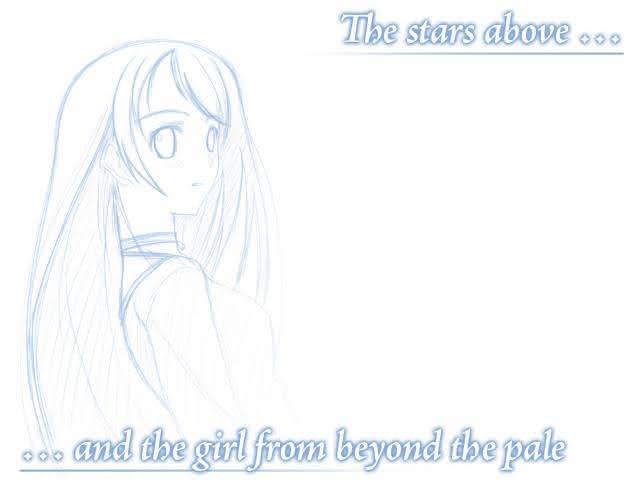
Red Shift also contains a short epilogue after the end credits, meaning this is one game where there is a very practical reason to sit through said credits. However, the credits segue directly into the epilogue, meaning that it is not added as a new item to the start menu like the epilogues in games such as May Sky and Return to Shironagasu Island (see review).
Red Shift takes about three hours to read, give or take, depending on one’s reading speed and level of attention. While Red Shift is not long by visual novel standards generally, it is long for an al|together translation since most of the novels in the collection are very short. Of the ones that I have reviewed thus far, only May Sky is longer.
Visual Presentation
Red Shift is visually simple like most of the al|together projects. However, it does a few unique things with its presentation that merit praise and set it apart from many of the other visual novels in the collection.
Backgrounds
Red Shift uses photographs with modifications for most of its backgrounds – similarly to most al|together translations. The majority Red Shift takes place outdoors in the evening. To give off an evening aesthetic, its outdoor backgrounds are gray scale.
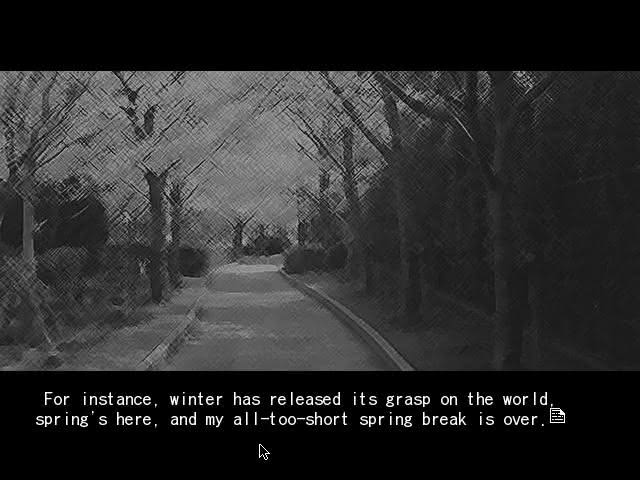
A few indoor backgrounds have color.
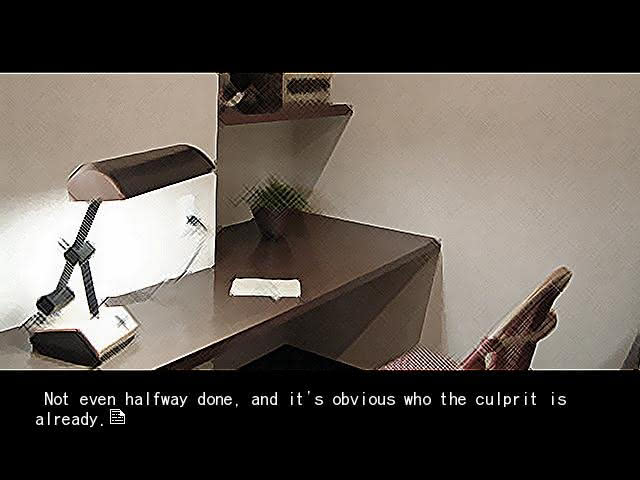
Red Shift does include a few painted backgrounds which are used when the characters gaze into the sky.
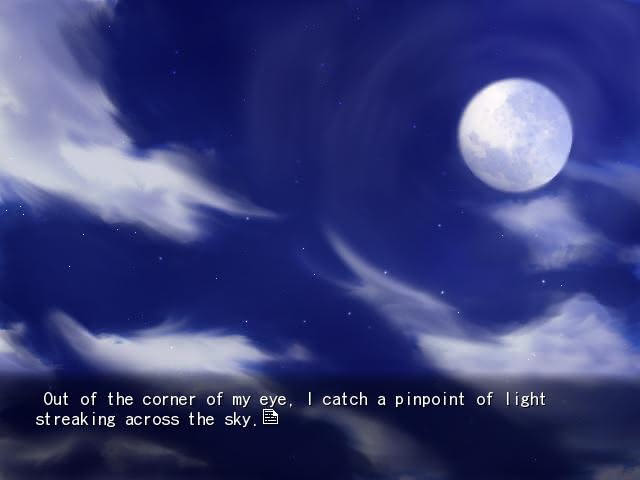
There are a few unique backgrounds as well. For example, Red Shift does eventually explain its name:
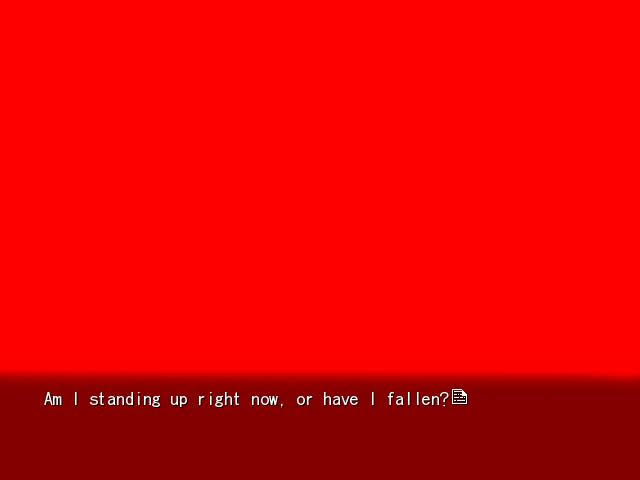
The backgrounds themselves are nothing special, and are relatively tame even by early-2000s doujin NScripter game standards. However, as I will explain in my subsection on perspective (coming up soon), there is more to the backgrounds than meets the eye. Each background was carefully chosen and implemented to give the player the idea that he or she is seeing the world through Kouya’s eyes. The seemingly simple choices take on an insightful meaning when viewed with attention to the developer’s interest in perspective.
Text Boxes
Many NScripter and ONScripter visual novels eschew text boxes and run dialogue boxes. However, Red Shift has a more modern presentation – despite being on the older side – and confines dialogue to text boxes. It does some interesting things with the text boxes that we will return to in a moment.
Character Implementation
We have seen with the al|together games that some use character sprites and portraits (i.e., you can see a portrait of the character who is talking) and some do not. Red Shift falls into the former camp. Kouya does not have a full body portrait because he is always the view-point character. However, Mikoto and two other characters have full body portraits.
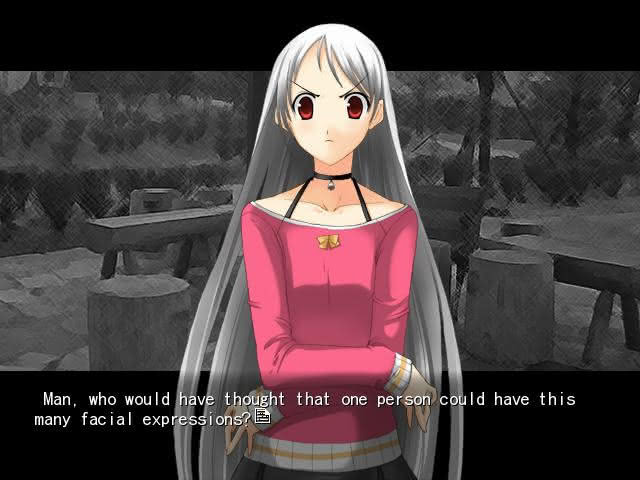
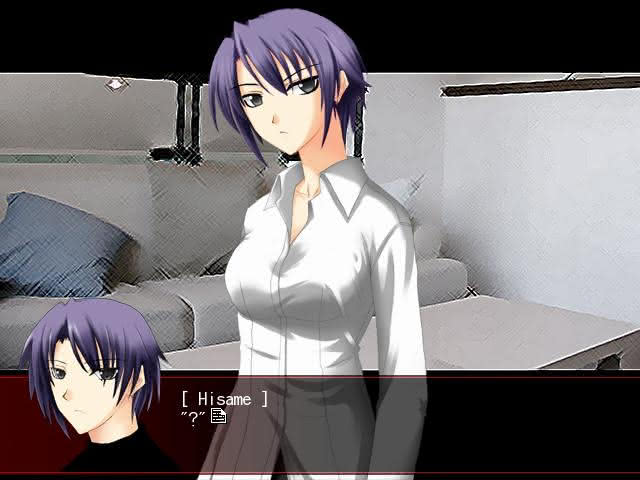

The full body character portraits are not particularly expressive. For example, Mikoto, who dominates Red Shift in terms of screen time, has only a few expressions on her full body portrait – and she spends much of the game scowling at Kouya. However, these characters also have a second portrait. When a character is actually speaking, his or her head appears in the text box next to the dialogue. I say he or she because this applies to Kouya as well, even though he does not have a full-body portrait. These text box head shots are much more expressive than the full body portraits. In the case of Mikoto, the many expressions highlight her tendency to run hot and cold.
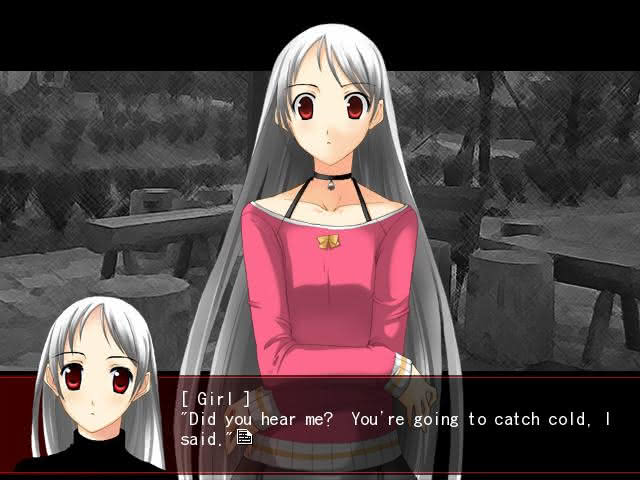
However, because the text box head shots have a much wider range of emotions than the full body portraits, we often have a disconnect between the two – with the text box portrait being much more dramatic than the full body portrait.
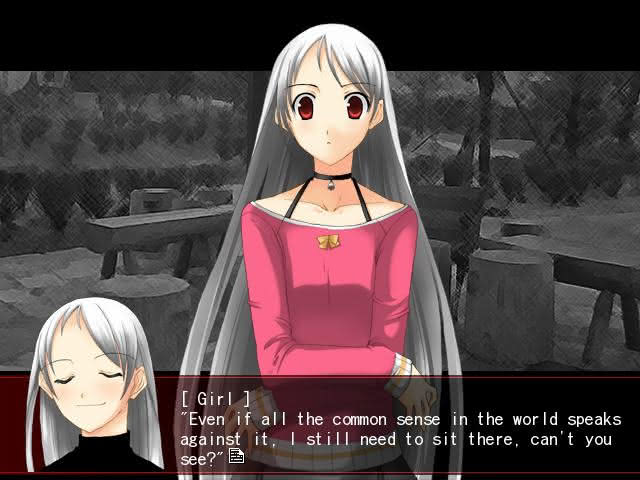
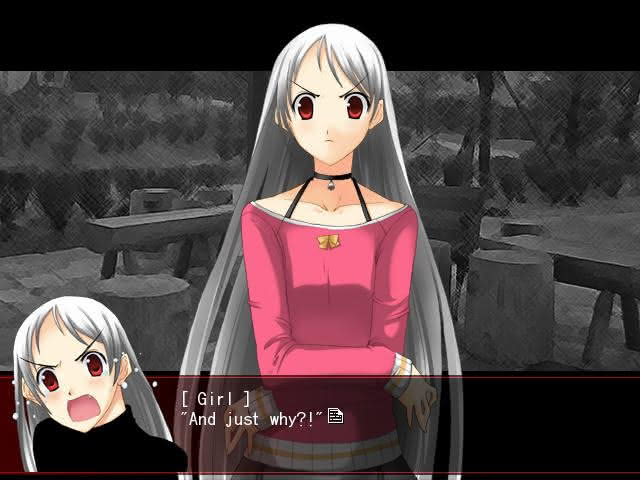
Another minor niggle for me is that the head shots are black from the neck down. For example, the text box head shots of Mikoto make it look like she is wearing a turtle neck whereas we can see in her full body outfit that she is wearing an off-the-shoulder pink shirt and a choker with a bell. The other characters also have the “black turtleneck head shot” effect despite not wearing black turtlenecks.
Red Shift’s method is similar to what we saw in Instant Death! Panda Samurai, which was one of the more experimental al|together submissions. While Red Shift is a more serious project, it has some issues with its dialogue implementation that Panda Samurai did not
Red Shift’s dual-character portrait system comes with some good and bad. It benefits Kouya in that we can see his face and expression when he is talking, even though he does not have a full body portrait. Another interesting (and well-done) point with Kouya is that his text box portrait only appears when he is actually speaking. This makes it easy to distinguish his internal monologues from his talking.
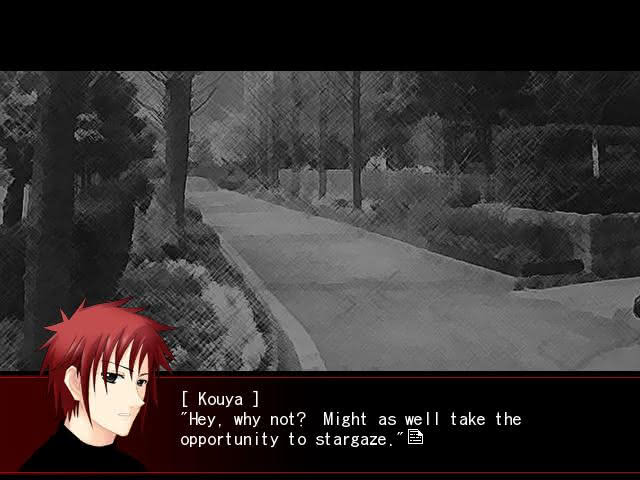
The effect is a bit odd for Mikoto since we see two of her on screen, and one image of her is usually much more expressive than the other. Ideally, we could have consolidated Mikoto and the other characters with speaking roles into one image – much like May Sky did with its protagonist. At the very least, it would have been preferable for more consistency between the text box head shot and the full-body portrait. However, Mikoto very much needed all of the expressions depicted in her head shot portrait, so I will take the disconnect over only having the limited set of expressions on her full body portrait.
Character Design
The character designs in Red Shift are adequate. The majority of the game is spent either with Kouya’s internal monologues (no character portraits present for those) or conversations with Mikoto, so Mikoto’s design is by far the most prominent feature of Red Shift.
The choice to make Mikoto albino – something I discuss more in a companion article – was smart from Red Shift’s perspective. While it is not critically important to the plot (it comes up and has some relevance, but Red Shift did not require Mikoto to be albino), it makes Mikoto far more memorable than she would have been with a less distinct character design. That the author depicted her with red eyes was an immediate tip that she was actually albino instead of being given white/silver hair for aesthetic purposes.
As I noted above, Mikoto’s head shot portraits, while having the same lack of polish as her full body portrait, effectively show her wide range of emotions – which have a tendency to shift dramatically when Kouya pushes her buttons. I will say that although the head shot was not intended to give Mikoto a black turtleneck, that would have been a more effective character design choice for her than the pink shirt she was given – albeit her in-game outfit does match her personality.
Kouya’s sister and a third character have ordinary, unmemorable designs. Red Shift’s characters betray the fact that it is the product of a one-man indie effort, but they get the job done.
Mastery of Perspective
The most praiseworthy aspect of Red Shift’s visual design is its mastery of perspective. The game is always aware that Kouya is the view-point character – and by this I mean it is aware that the player is supposed to be seeing the world through Kouya’s eyes. Attentive readers will note that the images are carefully chosen to give the player the idea that he or she is seeing the world as Kouya sees the world. When Kouya talks about the sky, the background promptly shifts to the sky. There are a number of scenes where Kouya closes his eyes – and for all of these scenes, Red Shift goes black . In several scenes, Kouya’s eyes open to see something different than what he was looking at when he closed his eyes. This is also handled effectively. Red Shift’s careful consideration of perspective is the most technically impressive thing about its design and something that many more visual novels, including commercial efforts, should consider more carefully.
CG Scenes
Red Shift, like many visually simple indie ONScripter translations, includes several fully drawn backgrounds (CG scenes). You will find a couple of non-spoiler examples below:
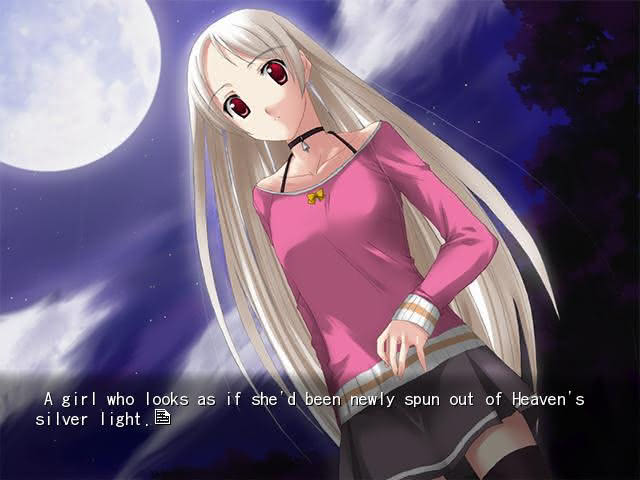
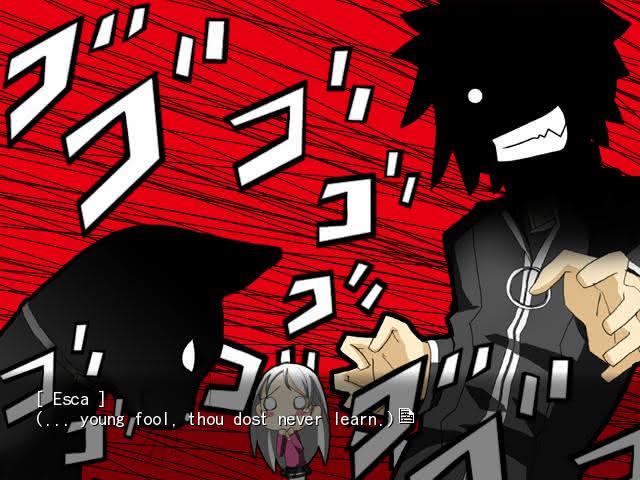
These backgrounds are visually more dynamic than Red Shift is in its normal state and are decently well-done. Moreover, several of the backgrounds that include Mikoto retain the director’s careful attention to Kouya’s visual perspective. However, there are relatively few fully drawn backgrounds – just 11 in total for a game with about three hours worth of reading – and almost half of them appear very late in the story. The backgrounds are nice to have, but they are not as numerous or as memorable as some other games that I have looked at such as Shooting Star Hill (see my review) or May Sky.
Music and Sound
Red Shift includes a solid selection of background music tracks which fit the story’s calm, melancholic, and ethereal mood well. I had no complaints about the background music in terms of sound, mood, or being overly repetitive. With that being said, the tracks are not memorable outside the context of Red Shift, perhaps evinced by the fact that the game does not include a music list or jukebox feature.
Translation Quality
Before offering thoughts here, I must include an excerpt from Red Shift’s Readme file from the translation team:
It also serves as our challenge to all translators who are considering participation in al|together 2006. The piece was translated in a period of three weeks, one hour a day at most, while the lead translator was working an ICU rotation that had him in the hospital for over 100 hours a week.
That is impressive. Red Shift is a long visual novel by the standard of al|together translations (not long by visual novel standards generally, however) – taking about three hours to read. Translating a story of this length in three weeks would be no small feat even without the lead translator having been working for 100 hours per week in the ICU during those three weeks. Although we are sixteen years late in doing so, I commend the translation team, led by Mr. Seung Park, for this impressive effort.
I always preface my translation analysis by noting that I have not seen the original Japanese game, and even if I had, I would be unable to read it. Instead, I judge the translations solely based on how well they read in English – being unable to assess their fidelity to the original.
Red Shift is one of the smoothest-reading translations that I have come across in the al|together collection, and at no point in the nearly-three-hour reading time did I come across anything particularly jarring or awkward. It compares favorably both to many commercial translations and to some of the shorter al|together games, which generally read quite well.
The only translation thing that jumped out to me was where Kouya offered “John Doe” as his fake name to Mikoto in their first meeting. This got the point across, but it still felt a bit off in light of the fact that all of the other names in the game are clearly Japanese. With that being said, I am not aware if there is an obvious English alternative to convey the joke without a translator’s note. Since the game was not structurally amenable to such notes, I venture no complaint about the choice.
The Readme gives the impression that Insani used the Red Shift translation to throw down the proverbial gauntlet for the al|together 2006 festival and establish a high standard for other translators to aspire to. The 2006 translations all read well in English, and Red Shift is among the best.
Writing and Story Quality
A visual novel with about three hours of reading and no choices depends almost entirely on its story to keep readers engaged. On the whole, I liked Red Shift and, when it is all said and done, it will likely have a place in the upper-half of al|together visual novels. While my overall impression is positive, it is not unequivocally so, because Red Shift does not quite match the quality of a couple of longer al|together visual novels that I reviewed previously – May Sky and Shooting Star Hill.
While Mikoto is the most visually memorable character of Red Shift, Kouya is its most important character. The whole story is seen through Kouya’s eyes and seasoned with Kouya’s narration. Moreover, I will say without spoilers that the character who is ultimately called upon to drive the story to its conclusion is Kouya rather than the proverbial heroine.
Fortunately, Kouya is an unusually strong protagonist. Although he is a view-point character, he is not a mere stand-in for the player – something that would not work well in a kinetic visual novel of this length. Kouya is given ample opportunity to explain himself, his background, and his perspective. His initial irritation with Mikoto’s rudeness is understandable and his eventually (somewhat) warming up to her also makes sense. Kouya even explains why he is sometimes compelled to tease Mikoto and get reactions out of her – something that is not difficult to do.
Although Red Shift has no choices for the player to make, the game comes down to an important choice for Kouya. Wrapped in that choice is the central question of Red Shift – a question which ties into Insani’s describing both Kouya and Mikoto as “selfish.” That description is technically true in context, but context is required. Without spoiling, I will present a key question in Red Shift as searching for where selfishness ends and selflessness begins.
Mikoto is written as a tsundere character – meaning that she is harsh and volatile on the outside but has a warm and friendly side as well. Her tsun tendencies are exaggerated and comical rather than mean, and she can be charitably described as petulant. It is not difficult to see how she grates on Kouya in their initial meeting. Of course, when a mysterious albino girl shows up in a park in the evening and thereafter appears only at that place and time, and when she leaves questions about herself unanswered, even an inexperienced visual novel reader will suspect that there is more to the story than what is being presented initially. This is true of Mikoto – although I am limited in what I can say.
On the whole, I enjoyed Mikoto’s character – and some of the peculiarities of her behavior early in the game are explained by her peculiar circumstances, which are revealed later in the game. One’s mileage may vary on some of Mikoto’s antics, but her problems, strange as they are, are human problems – and she is ultimately a sympathetic character. The manner in which she becomes sympathetic in Kouya’s eyes touches on one of the more deftly written threads of Red Shift.
With respect to other plot points, I note that Red Shift is usually (but not always – see my complaint about the slow beginning below) economical with the points it introduces. When Kouya makes a point of something, that something is usually relevant to figuring out what is going on, even if the relevance is not obvious without more information. There are exceptions – but Red Shift’s script is disciplined for a one-man non-commercial effort of its length.
Having presented my positive impressions of Red Shift’s main duo and why I think its conclusion was ultimately well-thought out and intelligent, I also had some issues with it.
Firstly, Red Shift starts very slowly. The good that comes from this is that Kouya is given time to establish his own character on his own terms. However, there is quite a bit of reading before another character (unsurprisingly, Mikoto) makes an appearance – and while I like Kouya, the long initial monologue will lose some readers who do not know what they are getting into. The slow start is not helped by the lack of visual diversity before Mikoto enters the stage.
Secondly, while I am not a fan of complaining about tropes so long as the so-called tropes are well-implemented in the context of a good story, Red Shift does fall back on quite a few. Both of Kouya’s parents are dead. Kouya goes to an almost-all girl’s school (granted the school matters little). Mikoto cannot cook. Et cetera. Red Shift, solid as it is, is neither creative nor ambitious. The events of the main story and Mikoto’s circumstances will not be unfamiliar to people who consume anime, manga, and visual novels – but I think that the matter of Mikoto and the story’s evolution are handled more than well enough to excuse some of the generic points in the main story.
Thirdly, Red Shift’s occasional attempts to be a comedy tend to fall flat. Its best source of comedy is when Kouya decides to get a rise out of Mikoto – and one can understand how Mikoto’s personality and temper cause him to do this. That is, Red Shift’s best humor comes from natural character interactions. When it goes out of its way to be funny, it struggles.
Finally, some may have issues with Red Shift’s ending – in that it largely opts to tell instead of show. I saw this complaint in a few comments in the discussion on its Visual Novel Database page. However, I had no particular issue with the ending – perhaps unsurprising from someone whose favorite movie is 5 Centimeters Per Second. Moreover, I think that there is a logical thematic reason for why Red Shift ended in the way that it did, but I will reserve my thoughts on the subject for the purpose of this spoiler-free review. For whatever it is worth, Red Shift’s ending is significantly more decisive than the ambiguous ending of From the Bottom of the Heart (see my review), another very good (albeit short) al|together effort.
Menus and Extras
For some reason, Red Shift’s menu, as well as its title page, is rendered on its side.


Why this is I know not, but Red Shift has ordinary menu options including saving and loading. One can skip text using the ctrl key. One minor inconvenient design point is that using the scroll wheel does not allow one to read text history. Instead, one must trigger history from the menu.
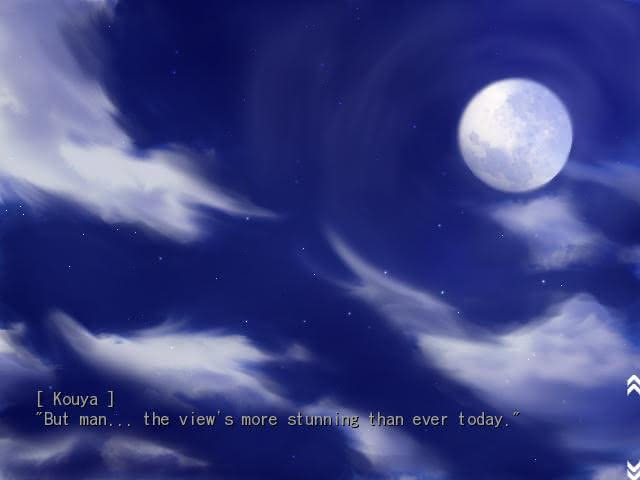
Upon completing Red Shift, a CG gallery is added to the start menu, but there are no additional extras.
A Note on Red Shift’s Development
The Red Shift Readme contains a statement from the game’s sole creator:
As these are all the efforts of one person – from the art to the writing to the scripting – I can give you no unbiased opinion about how good or bad it is.
I was genuinely impressed when I read this. While all of the al|together games were small hobby projects, most had more than one person working on them. Moreover, while Red Shift is short in the grand scheme of visual novels, it is long for a one-man solo effort, and significantly longer than most of the other al|together translations.
Red Shift is worth reading because it is, despite some minor flaws, a good piece. That it was entirely the product of one person’s labor is genuinely impressive. This is exactly the sort of project that should encourage talented indie developers.
An Anecdote About Watching the Credits
Before concluding, allow me to tell a funny story. Red Shift is one of the al|together visual novels that I did not play in the first instance for this review. I first read it in the early 2010s, I would guess in the 2011-2013 range. I recalled enjoying it, but I did not remember the plot in great detail. Now without saying much, I discovered upon reading again for a review that my memory of the ending was off. It did not take me long to discover why.
If one believes that Red Shift is over with the last scene before the end credits – which happens to the the last scene I remember from my initial play-through – he or she will be left with a very different impression of how Red Shift concludes than someone who sticks around. The reason for this is because the actual final scene runs after the end credits, and it retroactively paints the final scene before the end credits in a markedly different light.
I cannot say for certain whether I saw the final scene when I read Red Shift for the first time. That first reading occurred at least a decade ago. It is entirely possible that I watched part of the credits before closing the game or that the final scene before the credits – which was quite dramatic – left more of an impression than the after credits scene . However, in light of the fact that I have written two articles on the subject of watching (or not watching) credits, I will strongly advise readers of Red Shift to watch the relatively short credits – both out of respect to the game’s sole creator and the excellent translation team and because there is a very important scene after said short credits.
Conclusion
Red Shift is a solid visual novel on the whole even without taking into account the fact that it was a solo effort. I recommend it to people who enjoy visual novels generally and I especially recommend it to those who are interested in reading lesser-known visual novels from the early 2000s. While I am still early in the al|together review project, I am reasonably confident that Red Shift will earn a spot among the better half of the visual novels in the collection.
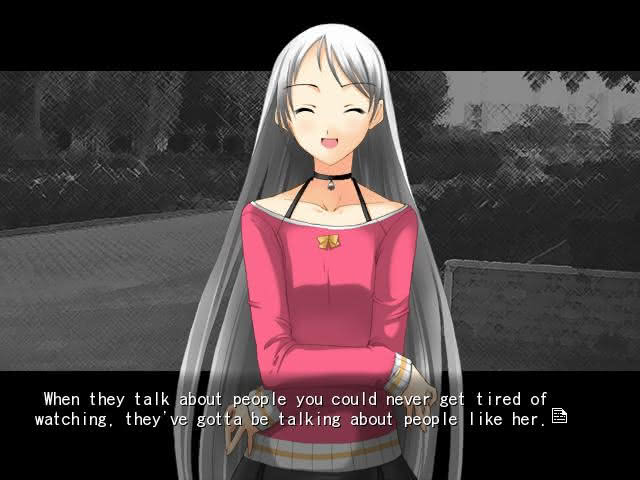
Red Shift is not a perfect story or quite on the level of the best visual novels submitted to the al|together festival, but it is solidly written and translated, possesses good attention to detail, and ends in a satisfactory manner. While I enjoyed it, I will grant that it may be a bit difficult for people who prefer interactive visual novels – especially in light of its slow first section.
I tip my hat to Red Shift’s solo developer for the impressive effort and, as always, thank Insani and everyone behind the al|together festivals for undertaking the effort to make it available to English readers.
Be sure to also read my in-depth analysis of how Mikoto’s albinism is handled in Red Shift.